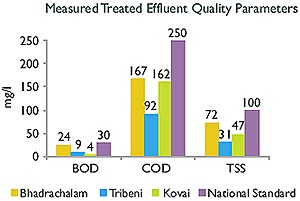The Voluntary Charter
Charter on Corporate Responsibility for Environmental Protection (CREP) proposed by MoEF (Ministry of Environment & Forests) and CPCB (Central Pollution Control Board) requires large Pulp and Paper Mills to ensure:
1. Wastewater discharge of less than 100 KL per tonne of paper
 Our Paperboards & Specialty Paper business’ performance in this regard has been exemplary: Our Paperboards & Specialty Paper business’ performance in this regard has been exemplary:
The recent NPC report proposes the following three levels on specific wastewater discharge for integrated Pulp & Paper Mills -
(Category A - applicable to Bhadrachalam): Benchmark:
50 cubic m/tonne, Best achievable: 53 cubic m/tonne and Relaxed standard: 63 cubic m/tonne.
The Bhadrachalam unit is steadily progressing towards achieving the benchmark standard.
2. Utilisation of treated effluents for irrigation - wherever possible
 Our treated effluents are well below the stipulated discharge norms. Plans are in place to achieve 100% discharge on land for irrigation at the Bhadrachalam and Tribeni units shortly. Our treated effluents are well below the stipulated discharge norms. Plans are in place to achieve 100% discharge on land for irrigation at the Bhadrachalam and Tribeni units shortly.

3. Discharge of Adsorbable Organic Halides (AOX) to 1.0 kg/tonne by March 2008
Average discharge level by Indian Paper/Paperboard mills is 0.46–0.8 kg/tonne (Comprehensive Industry Document for Large Scale Paper Mills, study conducted by Central Pulp and Paper Research Institute, 2007).
The guidelines by the World Bank for new paper mills stipulate a level of 0.2 kg/tonne of AOX in effluent
discharge.
In our organisation, Adsorbable Organic Halides (AOX) is applicable only to the Bhadrachalam unit, where AOX levels are a mere 0.0083 kg/tonne of paperboards.
4. Installation of Lime kiln by March 2007
The Bhadrachalam unit, where this norm is applicable, has a lime kiln in operation for the last five years.
5. Odour control
This is planned to be achieved by March, 2008,
by burning the reduced sulphur emissions in boiler/lime kiln.
6. Effluent Colour removal
The Indian Paper Manufacturers Association has engaged the Central Pulp and Paper Research Institute to suggest measures for colour removal from effluents. The study is in progress.
Actual measured (average) value of all the effluent parameters in our Paperboards & Specialty Paper mills in 2006-07 was far below national standards.
 |
BOD - Biochemical Oxygen Demand,
COD – Chemical Oxygen Demand,
TSS – Total Suspended Solids.
All the above units are in
mg/l. All figures rounded off to the nearest digit. |
|

